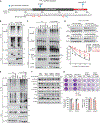The TRIM4 E3 ubiquitin ligase degrades TPL2 and is modulated by oncogenic KRAS
- PMID: 39178114
- PMCID: PMC11472288
- DOI: 10.1016/j.celrep.2024.114667
The TRIM4 E3 ubiquitin ligase degrades TPL2 and is modulated by oncogenic KRAS
Abstract
Loss-of-function mutations in the C terminus of TPL2 kinase promote oncogenesis by impeding its proteasomal degradation, leading to sustained protein expression. However, the degradation mechanism for TPL2 has remained elusive. Through proximity-dependent biotin identification (BioID), we uncovered tripartite motif-containing 4 (TRIM4) as the E3 ligase that binds and degrades TPL2 by polyubiquitination of lysines 415 and 439. The naturally occurring TPL2 mutants R442H and E188K exhibit impaired TRIM4 binding, enhancing their stability. We further discovered that TRIM4 itself is stabilized by another E3 ligase, TRIM21, which in turn is regulated by KRAS. Mutant KRAS recruits RNF185 to degrade TRIM21 and subsequently TRIM4, thereby stabilizing TPL2. In the presence of mutant KRAS, TPL2 phosphorylates and degrades GSK3β, resulting in β-catenin stabilization and activation of the Wnt pathway. These findings elucidate the physiological mechanisms regulating TPL2 and its exploitation by mutant KRAS, underscoring the need to develop TPL2 inhibitors for KRAS-mutant cancers.
Keywords: COT; CP: Cancer; CP: Molecular biology; KRAS; MAP3K8; RNF185; TPL2; TRIM21; TRIM4; Wnt/β-catenin; protein degradation; ubiquitination.
Copyright © 2024 The Author(s). Published by Elsevier Inc. All rights reserved.
Conflict of interest statement
Declaration of interests The authors declared no competing interests.
Figures







References
Publication types
MeSH terms
Substances
Grants and funding
LinkOut - more resources
Full Text Sources
Molecular Biology Databases
Miscellaneous

